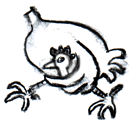Cyborgs will contain implanted pumps driven by living cells
 Another interesting instance of the unity of organisms and machines; here, biological parts that have been machines for eons can now be manipulated by humans to build extremely small machines.
Another interesting instance of the unity of organisms and machines; here, biological parts that have been machines for eons can now be manipulated by humans to build extremely small machines. Living heart cells drive microfluid pump - tech - 30 November 2006 - New Scientist Tech: "A tiny pump driven by living heart cells has been developed by researchers in Japan. Future versions could perhaps power medical implants or devices that analyse biological samples, the researchers say.
The pump is made from a hollow sphere of flexible polymer with tubes connected to opposite sides. The sphere is coated with a sheet of cultured rat heart muscle cells and these cells drive the pump with pulsing contractions."
Here is one area where Descartes was right: "The only difference I can see between machines and natural objects is that the workings of machines are mostly carried out by apparatus large enough to be readily perceptible by the senses (as is required to make their manufacture humanly possible), whereas natural processes almost always depend on parts so small that they utterly elude our senses," he wrote in Principles of Philsophy (1644). Now that we can visualize the parts, organisms are demonstrably mechanical, and indeed at the cellular level all processes can be seen as "natural machines."
See also the related articles "Tiny 'hamster wheel' turned by bacteria" (28 August 2006), "Robo-scallop could carry drugs through the body" (24 July 006), and "Fluid chip directs wandering sperm" (22 October 2005).



0 Comments:
Post a Comment
<< Home